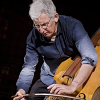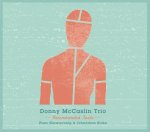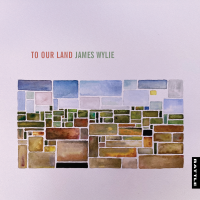Home » Jazz Articles » Megaphone » Mark Dresser: Telematics
Mark Dresser: Telematics
Telematics generally refers to the interface of computers, communication and performance.
My sense of 'community' radically changed in 1998 while I was on tour in Europe. During a break after a soundcheck, I checked my email to read the devastating communication that beloved saxophonist Thomas Chapin was being taken off of life support. At that moment I was mentally transported from the locality of the club and connected to a larger group of family and friends of Thomas who were all experiencing the sad cognizance of the last few hours of his too short life. For the rest of the evening I was no longer just in that club, but in a larger space, connected to a larger community, bound by sadness. It was my first vivid experience that this mode of distance communication transcended time and place.
In 2004 I left New York to accept a teaching position at the music department at UC San Diego. I was able to stay in close contact with my community of friends and colleagues in New York through email and cell phone. I made a point to come to New York to perform as much as possible and through filesharing of sheet music and sound files, a lot of the musical preparation that, in an earlier day, might be the sole domain of the live rehearsal could be done at a distance. I certainly missed the casual gig, at which one could perform new music with new colleagues. In the not-so-distant future this may not be the case because of telematic performance. Through the development of telematic music there is the opportunity to regain access to local scene dynamics, not only in New York but also to scenes worldwide.
Telematics generally refers to the interface of computers, communication and performance. It has a modern history of about 20 years. Due to the dedicated work of pioneers, generosity of friends and colleagues and support from a university that is invested in the potentials of technology, I have been able to collaborate, rehearse and perform with other musicians in multiple locations.
I began my formalized work with telematics in September 2007. Noted composer/improviser Pauline Oliveros, a pioneer in telematics, whom I've known since 1971, outlined the parameters of telematic performance over dinner at the Guelph Festival. She explained that there were three interdependent levels of organization: technical, administrative and artistic. Sarah Weaver, her apprentice, as well as an expert Soundpainting conductor, composer and arts administrator, took notes. Sarah was responsible for providing me with the specific documents and the followup support. With Sarah I have spent countless hours over the past year organizing, collaborating, documenting and discussing the properties and potentials of this medium.
Since last September I've participated in three different telematic performances, ranging from 7 to 30 musicians, in three different locations. Typically there are audiences at each location listening and viewing their local ensemble together with the composite group streamed in real time on the web.
The first performance on Nov. 16th, 2007 was between the research groups from Stanford, UCSD and Rensselaer Polytechnic Institute in Troy, NY with close to 30 musicians. The pieces on this concert were various kinds of structured improvisations. Two of the pieces utilized Soundpainting, the versatile interdisciplinary conducted sign language developed by Walter Thompson.
"Celleto Concerto" featured Chris Chafe as the improvised soloist. The ensemble accompaniment between the ensembles in Stanford and Troy was structured and conducted by Sarah Weaver. "Water Naught" was a duet between San Diego and Troy, with Sarah and I conducting our respective local ensembles. We had agreed that we would develop palettes over the seven weeks leading up to the concert based on metaphoric imagery translated into specific musical textures. Smaller groupings of members from the two ensembles used email, SKYPE, iChat, iVisit, Google Docs (and when all else failed cell phone) to develop every aspect of the metaphoric palettes. "Three Ways" was an orchestrated improvisation between all three ensembles—UCSD, Stanford and Troy—led by a co-located string trio of Chris Chafe (celleto, Stanford), Curtis Bahn (dilruba, Troy) and myself (contrabass, San Diego).
The second concert on Feb. 13th, 2008 included a group of professional musicians at three locations, all with whom I've shared varying degrees of history, including pianist/composer Myra Melford and the computer musician/engineer David Wessel at CNMAT at UC Berkeley. Cellist/composer Chris Chafe was at CCRMA at Stanford. In San Diego at CalIT2 I was with trombonist Michael Dessen from UC Irvine, visiting drummer Billy Mintz and UCSD bass/baritone singer Phillip Larson.
The pressing question for this concert was whether or not we could play 'in time.' Everything I had read led me to believe that the inherent time lag or 'latency' would derail any possibility of performing with a real time 'feel' not to mention any sense of groove or swing. We were able to test this out at a distance of 500 miles. We decided to compose and arrange pieces for this concert specifically with the intention to check out aspects of time, including the metaphoric. Due to the effectiveness of JackTrip—a CD quality multi-track software developed by Chris Chafe at Stanford—the effectiveness of our team of technical collaborators and the musicians themselves, time proved to be not a problem. One piece, "Parawaltz," a tricky metric modulating cyclical form really tested it without vagueness. The concert is posted at YouTube.
The third concert on Apr. 27th, 2008 presented pieces expressly written for the telematic medium by composers Kristin Norderval, Monique Buzzarte, Michelle Nagai, William Swofford, Sarah Weaver and myself through the Deep Listening Institute. Participating ensembles included Stanford, UCSD and RPI. My piece "t/here in/to a/void form/less" was a collaboration with Sarah Weaver, further developing our usage of metaphor palettes and Soundpainting.
Telematics so far, has proven to be both rewarding and a promising performing venue due in large part to the sonic success of our audio software JackTrip. The latency with JackTrip is negligible, equivalent to the adjustment that musicians automatically are accustomed to when performing in a space with somewhat 'wet' acoustics. The experience of performing telematically is somewhere between live performance and playing in an isolation booth in a recording studio. One can hear the details of the attack of the remote instrument. Let's add one important fact: JackTrip only works on Internet 2, a dedicated fast/high bandwidth network developed ironically for the military and educational institutions. Currently telematics is not a 'plug and play' endeavor. It requires a team of collaborators with multiple levels of technical expertise, network sound, local mixing, local video, network video and streaming. It currently takes at least two hours of setup to troubleshoot each step in the process. Though admittedly cumbersome and time-consuming, it is paradoxically one of the most rewarding aspects of this work that it requires community cooperation to make it fly.
The weak link in telematic music performance is the audio-video synchronization. There are two issues. As of yet we don't have access to high-definition video software to match the quality of our audio software but more importantly video requires greater bandwidth and has greater latency than audio. It becomes an issue of what is good enough? Does the synchronization quality that we're now accustomed to on YouTube, for example, make the multiple location live performance unworthy? I think not. Once the hardware for this kind of performance becomes more of a plug and play process with better video resolution, will it be acceptable for professional live music performance? It all depends.
Let's be clear, telematics is not a substitute for live performance. It is another format and perhaps even another venue, with its own properties. As plug and play systems develop and the integration of video and audio quality improve, those potentials will reveal themselves.
Telematics is an improvisers and community medium. There is much to figure out and develop—assembly and operation of the technology, multiple levels of protocol, communication, shape of the acoustics of the signal—and envisioning and experimenting with its artistic possibilities. How it will best serve music is a personal priority and an exciting, intriguing and open question.
Mark Dresser is an internationally acclaimed bassist, improviser, composer, interdisciplinary collaborator. He is documented in over 100 recordings including nearly 30 CDs as a soloist, band-leader or co-leader. He is Professor of Music at University of California, San Diego.
Tags
PREVIOUS / NEXT
Support All About Jazz
 All About Jazz has been a pillar of jazz since 1995, championing it as an art form and, more importantly, supporting the musicians who make it. Our enduring commitment has made "AAJ" one of the most culturally important websites of its kind, read by hundreds of thousands of fans, musicians and industry figures every month.
All About Jazz has been a pillar of jazz since 1995, championing it as an art form and, more importantly, supporting the musicians who make it. Our enduring commitment has made "AAJ" one of the most culturally important websites of its kind, read by hundreds of thousands of fans, musicians and industry figures every month.





















